South Korea’s Transformation
From Post-War Poverty to Global Cultural Power

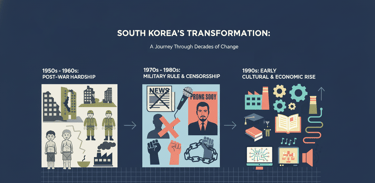
South Korea's Tumultuous Foundation: Poverty, Dictatorship, and Censorship (Post-WWII to 1990s)
The narrative of South Korea's rise to a cultural superpower is rooted in its turbulent post-World War II (WWII) history, a period marked by extreme poverty, military dictatorship, and severe restrictions on artistic expression.
Post-WWII Division and the Korean War
The starting point is August 15, 1945, when Japan officially surrendered, marking the end of WWII. Korea, which had been under Japanese rule, gained its freedom. This date is celebrated as National Liberation Day in both North and South Korea.
Initially, Korea was a unified country. The subsequent division occurred when the Soviet Union and the United States agreed to split Korea into two parts: Southern Korea, under U.S. command, and Northern Korea, under Soviet command. The initial plan involved a five-year trusteeship period, after which the ultimate goal was to reunite Korea as an independent nation. However, this plan failed as tensions escalated, signaling the beginning of the Cold War.
Birth of the Republic: Following elections in the U.S.-controlled South Korea, the Republic of Korea was officially born on August 15, 1948, established as a new, liberal, democratic nation.
The War: Just two years later, in 1950, the Korean War erupted when North Korea invaded the South in an attempt to unify the two Koreas by force. This conflict lasted for three years.


Post-War Poverty and the Rise of Dictatorship
The Korean War had devastating consequences, leaving South Korea as one of the poorest nations in the world.
• Extreme Poverty: At the time of the war's conclusion, South Korea's GDP per capita was lower than that of present-day Somalia and Haiti, both currently among the world’s poorest nations.
• Authoritarian Shift: This dire poverty took a heavy toll on democracy. South Korean President Rhee Syngman adopted an authoritarian stance and introduced constitutional amendments, leading the country to shift towards dictatorship.
• Military Rule: Although rigged elections in 1960 led to nationwide protests and Rhee's flight, a military coup soon unfolded. General Park Chung-Hee overthrew the government and established a military dictatorship. Even after Park's assassination in 1979, another military coup brought a new general to power.
• Restoration of Democracy: The revival of democracy in South Korea did not take place until 1987-88.
During this period (1962–1989), the dictatorial government, led by General Park, pursued an export-oriented industrialization strategy. General Park nationalized numerous private banks and controlled nearly all economic aspects, including interest rates, tax benefits, and import/export licenses. He used this control to promote large family businesses known as Chaebols (such as Samsung and Hyundai). These entities were shielded from foreign competition and used to drive exports of manufactured goods (like automobiles and semiconductors). This aggressive economic focus allowed South Korea's nominal GDP per capita to increase fiftyfold during this timeframe.
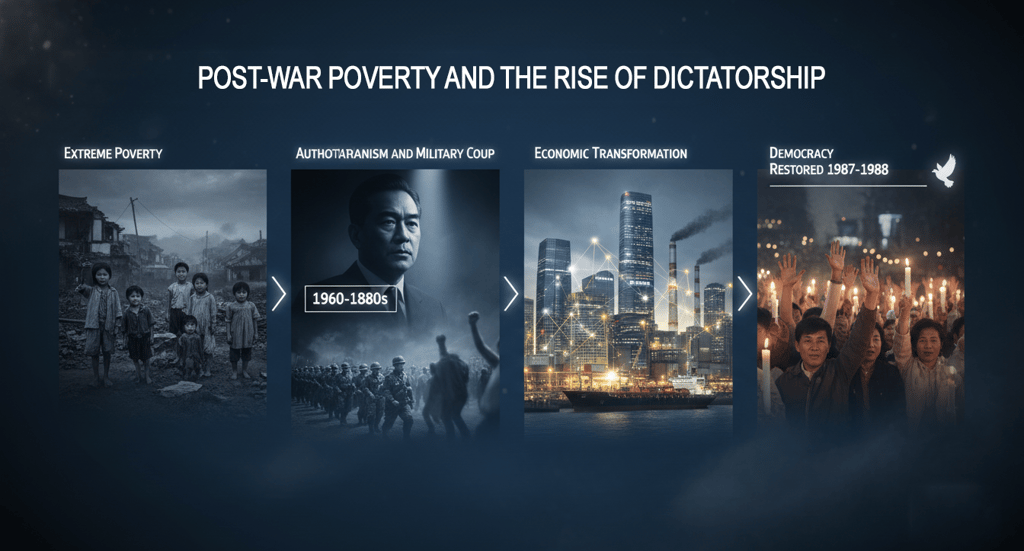

Severe Government Censorship
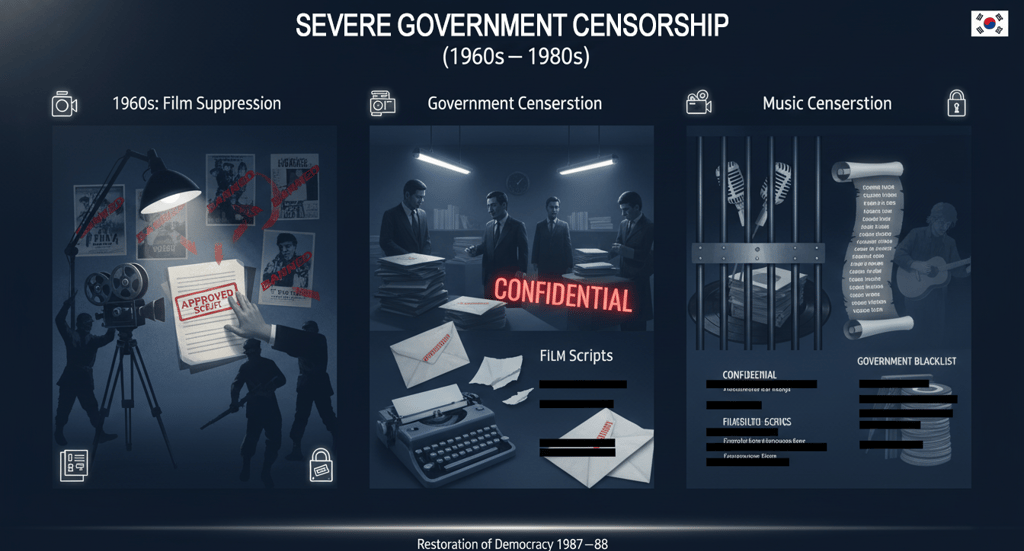

The prolonged era of military dictatorships had a lasting impact on South Korean culture, primarily through pervasive censorship.
Film Censorship (The Motion Picture Law)
In 1962, General Park Chung-Hee introduced a Motion Picture Law which became increasingly stringent through four revisions in the following decade.
• Mandatory Approval: Scripts for films released in South Korea had to undergo a government approval process. Once films were made, they were scrutinized to ensure they aligned with the approved official script.
• Allowed Genres: Certain genres were permitted by the government, including:
• Violent films, particularly martial arts films.
• Melodramas.
• Propaganda films, which were often financed by the government.
• Films with explicit content, known as 'hostess films,' which typically featured at least one character playing the role of a bar girl or a prostitute.
• Banned Content: Crucially, filmmakers were not allowed to create films addressing real socio-political issues. Criticizing the government was strictly prohibited.
Music Censorship: Restrictions also extended to music, particularly foreign content:
• 'Decadent' Music Ban: In 1975, the South Korean government implemented a ban on "Decadent" foreign music.
• Blacklists: This ban covered every foreign song that lacked a "moral standard," resulting in the creation of two extensive blacklists comprising over 260 songs.
• Banned Artists: The forbidden list included protest songs, rock songs, and folk songs, notably Bob Dylan's iconic 'Blowing in the Wind'.
These severe restrictions on artistic expression persisted until the restoration of democracy in the 1990s, marking a turning point that laid the ideological groundwork for the subsequent cultural boom.
The restoration of democracy in South Korea (1987-1988) initiated a decisive turning point, enabling the government to pivot from restrictive authoritarian policies to a strategic, export-oriented cultural development model. This shift, which unfolded throughout the 1990s, was characterized by the government's recognition of culture as an economic asset, landmark policy reforms, the removal of censorship, and massive digital infrastructure investment.
Post-Democratic Shift: South Korea's Cultural Strategy (1990s Onward)
Recognizing Culture as an Economic Asset
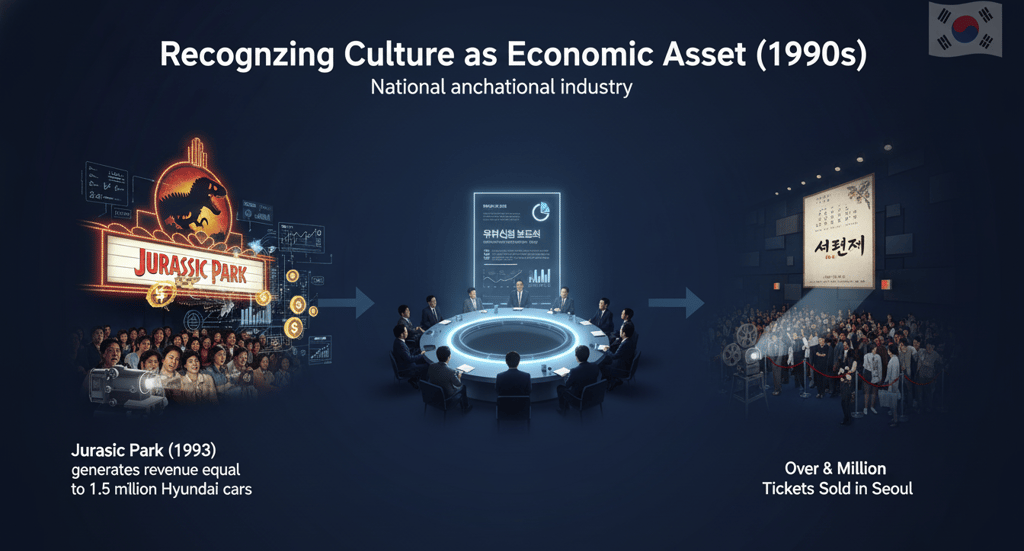

The impetus for turning culture into a strategic industry emerged in the early 1990s through two key realizations:
1. The Jurassic Park Effect (1993): The global success of the Hollywood film Jurassic Park caught the attention of the government. The South Korean Presidential Advisory Board on Science and Technology submitted a report to the President, highlighting the film's financial success and equating its revenue to that generated by selling 1.5 million Hyundai cars. This demonstrated the immense potential of media production.
2. Seo Pyeon Je's Domestic Success (1993): Simultaneously, the Korean film Seo Pyeon Je, based on traditional folk storytelling, was released. Despite expectations being low, as only Hollywood films were typically hits at the Korean box office, the film sold over 1 million tickets solely in Seoul, the South Korean capital. This success prompted the government to recognize the media industry's potential and decide to promote media production as a strategic industry.
Following this, the government took proactive measures to facilitate the growth of Korean culture as a global export.
Initial Government Reforms and Chaebol Involvement

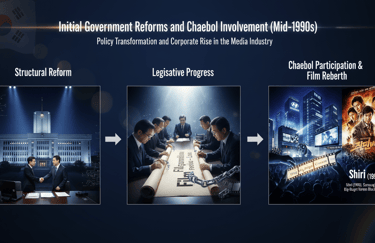
In the mid-1990s, the government began strategically dismantling old authoritarian structures and encouraging corporate investment:
• Establishment of the Cultural Industry Bureau: In 1994, the South Korean government established the Cultural Industry Bureau.
• Film Law Liberalization: The outdated and highly restrictive Motion Picture Law (introduced in 1962) was replaced with a new Film Promotion Law in 1996. Unlike the previous legislation, the new law encouraged filmmakers and artists to express themselves freely.
• Chaebol Investment: Major corporations, or Chaebols (such as Samsung, Hyundai, and Daewoo), began expanding into the media industry. These large family-owned businesses got involved in domestic film production, foreign film import, distribution, and exhibition. Since these Chaebols possessed significant financial strength, their involvement allowed for proper, big-budget film production for the first time in South Korea.
This corporate support led to the creation of the first Hollywood-style, big-budget Korean blockbuster: Shiri (1999). Produced by Samsung, Shiri had a budget of 2.4 billion won, adopted Hollywood storytelling techniques while maintaining distinctly Korean content, and outperformed the blockbuster Titanic in South Korea to become the highest-grossing Korean film at the time.
The Asian Financial Crisis (1997) and the Creative Opening
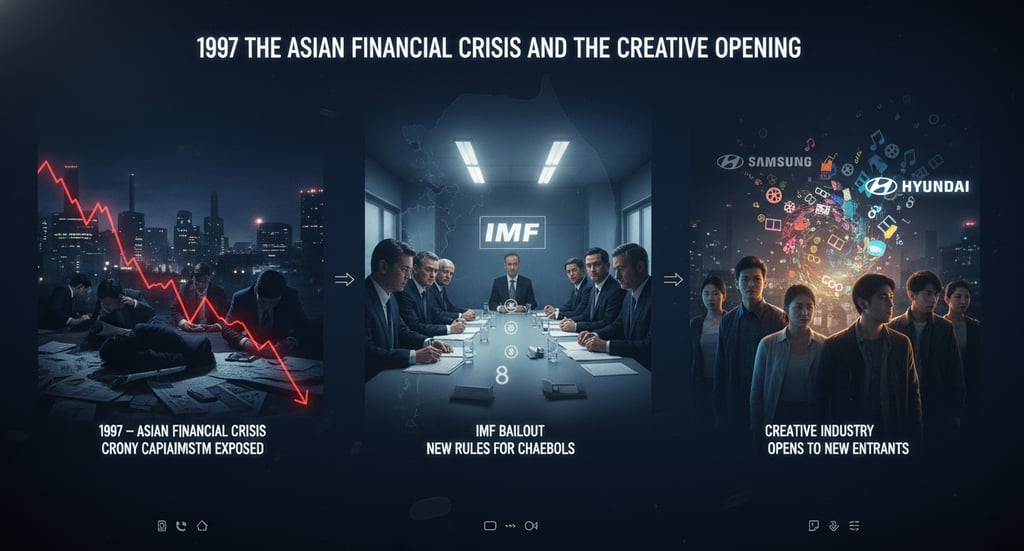

The financial crisis of 1997 dramatically impacted South Korea and, indirectly, its cultural landscape:
• Crisis and Accountability: South Korea was among the countries severely affected by the Asian Financial Crisis. Chaebols and crony capitalism were held responsible due to the revelation of practices like illegal insider trading, tax evasion, and indirect cross-ownership.
• IMF Intervention: To receive assistance, the International Monetary Fund (IMF) imposed conditions. The government subsequently introduced eight new rules regarding Chaebols. A key rule stipulated that these large family-owned businesses must focus solely on their core sectors and should not be allowed to enter all sectors.
• Withdrawal and New Entrants: Companies like Samsung and Hyundai withdrew from the film production business due to these new rules. While detrimental to the economy, this withdrawal paved the way for new, younger entrants into the creative industry.
Kim Dae-Jung’s Cultural Revolution (The 'Culture President')
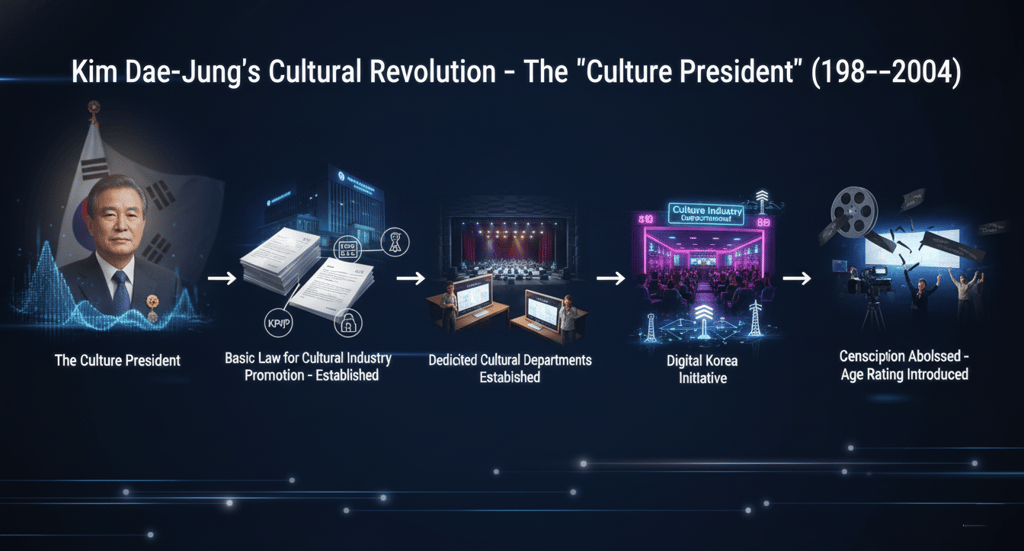

Following the financial crisis, President Kim Dae-Jung (who later won the Nobel Prize) recognized the potential of culture for economic recovery and national rebranding. Often referred to as the 'Culture President,' he and his successor, Roh Moo-Hyun, ushered in a cultural revolution.
His strategy involved four major pillars:
1. Fund Allocation and Dedicated Departments: In 1999, Kim established the Basic Laws for the Cultural Industry Promotion Project, allocating $148.5 million for its implementation. A dedicated department focusing on Korean Pop Music was also formed within the Ministry of Culture.
2. Infrastructure Development: Multimillion-dollar concert auditoriums were constructed. Furthermore, Culture Industry Departments were formed in universities nationwide, and Noraebangs (karaoke bars) began "popping up all over the country".
3. Digital Korea Initiative: Kim Dae-Jung laid the groundwork for the modern media environment by introducing broadband services in 1998. By 2004, aggressive promotion resulted in nearly 12 million households having broadband connections, earning Korea the title of "the world's most wired nation". This connectivity was crucial for the later surge in online content popularity.
4. Complete Removal of Censorship: Kim Dae-Jung relaxed all censorship laws. He abolished the board review process and introduced an American-style age rating system. This provided creative freedom for filmmakers who previously risked being labeled anti-national or facing arrest under the National Security Act for addressing serious socio-economic issues.
The Emergence of the "386 Generation" and Hallyu
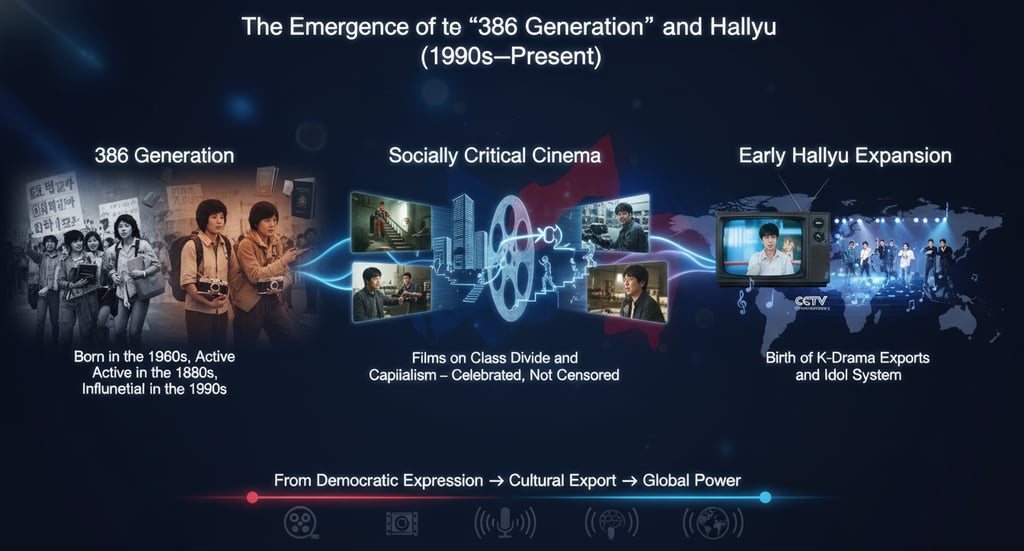

The lifting of travel restrictions and censorship laws allowed a new generation of filmmakers to thrive:
• The 386 Generation: By the early 1990s, a generation known as the 386 generation—individuals born in the 1960s who were politically active in the democracy movement of the 1980s—gained the opportunity to travel and study abroad. Until then, foreign travel for tourism had been restricted due to government concern over depleting foreign currency.
• Socially Critical Filmmaking: Many from this generation returned to become renowned left-leaning film directors who focused on making films about significant social issues.
• Directors like Bong Joon-Ho and Kim Ki-Duk produced works that served as critical commentaries on capitalism, such as Okja and Snowpiercer.
• Bong Joon-Ho's Parasite openly portrayed South Korea's extreme inequality and the social divide between the poor and rich. This film not only won the Palme d'Or but also made history as the first non-English film to win the Oscar for Best Film. Critically, the government, including President Moon Jae-In, praised the film instead of censoring it, celebrating its success as "the most Korean story".
Early Indications of Hallyu (The Korean Wave)
The cultural boom, known as Hallyu, began showing clear signs during this period:
• K-Drama Export: The drama What is Love marked a milestone in 1997 by becoming the first TV show officially exported to China, airing on China Central Television. Many consider this to be the initial indication of Hallyu.
• K-Pop Development: Kim Dae-Jung also played a pivotal role in improving relations with Japan by lifting the ban on Japanese content, leading to the introduction of J-Pop. This contributed to the structured idol system in K-Pop.
• H.O.T., formed by SM Entertainment, debuted in 1996 with an album that sold 1.5 million copies. The company developed this system by scouting and training individuals in singing, acting, dancing, and media communication, often determining their stage personality and name.
The collective impact of these deliberate strategies resulted in South Korea achieving its status as a cultural superpower, benefiting its soft power, economy, and tourism.
Connect
Join us in sustainable innovation efforts.
Engage
Support
© Donghaeng-manthan 2025. All rights reserved.
